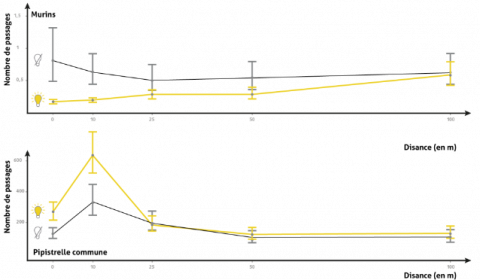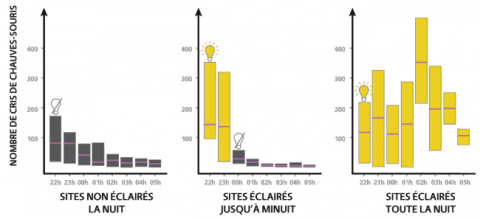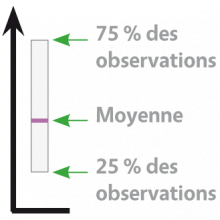Scientific results of Vigie-Chiro
Clémentine Azam, a doctoral student at the Muséum, sought to evaluate the impact of artificial lighting on chiropterans. She also wondered whether switching off lights at night (from midnight to 5 a.m.) would be an effective measure to limit these effects.
Light pollution and bats
Light pollution is generated by artificial lighting in a night environment. Streetlights cause disturbance to fauna (insects, bats, humans, etc.) and flora. This form of pollution affects a total of 20% of the world's land surface (with an increase of 6% per year) and affects terrestrial, aquatic and marine environments!
In terms of consequences for biodiversity, studies have shown that light pollution disrupts the daily and seasonal rhythms of several species. This form of pollution modifies the movement of species because light fragments the night-time landscape.
As everyone knows, bats live at night; however, their response to lighting varies according to species. The so-called aerial species are fast flying and hunt airborne insects. They are often detected hunting in the vicinity of street lights. On a local scale, there is therefore a positive effect of the streetlight attracting a considerable number of insects. On the other hand, another group of species, called gleaners, hunts more in crowded and closed environments (e.g. forests). These species gather insects that are lying on leaves or branches. As they fly more slowly, they are subject to a higher risk of predation and therefore seem to avoid lit areas.
Is night-time switching off (midnight to 5 a.m.) an effective measure to limit the impact of artificial lighting on chiropterans?
First of all, in her study, Clémentine was able to show that for the Common Pipistrelle, lighting seems to favour its presence: it is twice as frequent as in unlit areas that are turned off for part of the night.
Murins, on the other hand, seem to avoid even partially lit areas (according to the error bars, the difference is not significant between lighting all night or partially).
Earwigs seem to be the only ones to benefit from streetlighting measures. They hunt more significantly where lights are turned off. They would take advantage of the "groggy" insects, immobile on the ground or on the walls of houses, recovering from the "too much" light. Easy prey in short.
The period between midnight and 5 a.m. when streetlights are switched off is of little interest to most bat species. Other studies seem to show that it would be more effective to switch them off from 11 pm onwards.
Finally, as these graphs show, the light produced by street lamps impacts bats at a maximum distance of between 10 and 25 metres.
This result raises the question of how to create sufficiently wide ecological corridors for nocturnal species in an urban environment while respecting the feeling of safety of the inhabitants... And Clémentine does not have the answer to this question!
Positioning your data
The microphones you placed recorded the bat calls. The frequency with which bats visit the microphone location depends on the lighting. Interpret the number of calls recorded according to the light.
Using this graph :
On these graphs, for each hour, position your points according to the type of lighting at the site. The purple bar represents the average of the recorded calls, while the rectangle represents 50% of the observations (the lower edge of the rectangle marking the 25% limit and the upper edge 75% of the observations).
Understanding your result :
You have activity within 50% of the observations.
Your results correspond to the norm. This situation may be transitional, either towards an improvement in chiropteran activity or towards a deterioration. Continue your recordings to find out!
You have an activity above 75% of the observations.
You are in a rather encouraging situation - bat activity is higher than elsewhere! There are probably nearby developments that favour bats. Further surveys are needed to confirm this trend.
You have less than 25% of the observations.
The activity you have measured is lower than usual. This may be due to a temporary factor (e.g. the weather) or due to facilities that are not suitable for bats. Further night-time recordings will reveal more!







